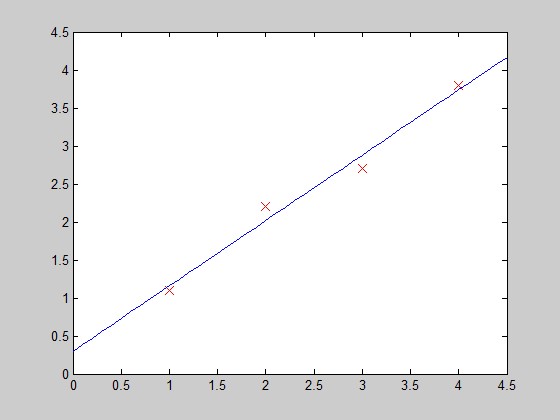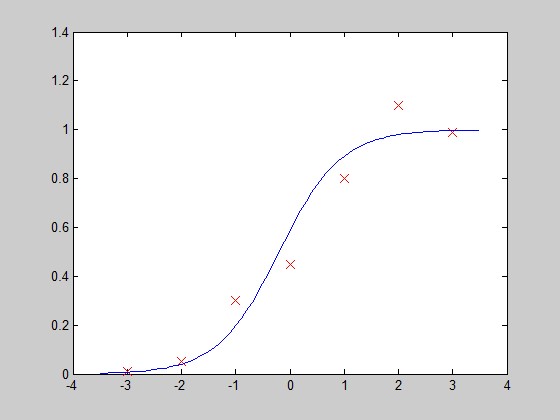原文:http://blog.csdn.net/abcjennifer/article/details/7732417
本讲内容:
Matlab 实现各种回归函数
=========================
基本模型
Y=θ0+θ1X1型---线性回归(直线拟合)
解决过拟合问题---Regularization
Y=1/(1+e^X)型---逻辑回归(sigmod 函数拟合)
在解决拟合问题的解决之前,我们首先回忆一下线性回归和逻辑回归的基本模型。
设待拟合参数 θn*1 和输入参数[ xm*n, ym*1 ] 。
对于各类拟合我们都要根据梯度下降的算法,给出两部分:
① cost function(指出真实值y与拟合值h<hypothesis>之间的距离):给出cost function 的表达式,每次迭代保证cost function的量减小;给出梯度gradient,即cost function对每一个参数θ的求导结果。
function [ jVal,gradient ] = costFunction ( theta )
② Gradient_descent(主函数):用来运行梯度下降算法,调用上面的cost function进行不断迭代,直到最大迭代次数达到给定标准或者cost function返回值不再减小。
function [optTheta,functionVal,exitFlag]=Gradient_descent( )
线性回归:拟合方程为hθ(x)=θ0x0+θ1x1+…+θnxn,当然也可以有xn的幂次方作为线性回归项(如 ),这与普通意义上的线性不同,而是类似多项式的概念。
),这与普通意义上的线性不同,而是类似多项式的概念。
其cost function 为:
逻辑回归:拟合方程为hθ(x)=1/(1+e^(θTx)),其cost function 为:
cost function对各θj的求导请自行求取,看第三章最后一图,或者参见后文代码。
后面,我们分别对几个模型方程进行拟合,给出代码,并用matlab中的fit函数进行验证。
在Matlab 线性拟合 & 非线性拟合中我们已经讲过如何用matlab自带函数fit进行直线和曲线的拟合,非常实用。而这里我们是进行ML课程的学习,因此研究如何利用前面讲到的梯度下降法(gradient descent)进行拟合。
1 function [ jVal,gradient ] = costFunction2( theta ) 2 %COSTFUNCTION2 Summary of this function goes here 3 % linear regression -> y=theta0 + theta1*x 4 % parameter: x:m*n theta:n*1 y:m*1 (m=4,n=1) 5 % 6 7 %Data 8 x=[1;2;3;4]; 9 y=[1.1;2.2;2.7;3.8]; 10 m=size(x,1); 11 12 hypothesis = h_func(x,theta); 13 delta = hypothesis - y; 14 jVal=sum(delta.^2); 15 16 gradient(1)=sum(delta)/m; 17 gradient(2)=sum(delta.*x)/m; 18 19 end
其中,h_func是hypothesis的结果:
1 function [res] = h_func(inputx,theta) 2 %H_FUNC Summary of this function goes here 3 % Detailed explanation goes here 4 5 6 %cost function 2 7 res= theta(1)+theta(2)*inputx;function [res] = h_func(inputx,theta) 8 end
Gradient_descent:
1 function [optTheta,functionVal,exitFlag]=Gradient_descent( ) 2 %GRADIENT_DESCENT Summary of this function goes here 3 % Detailed explanation goes here 4 5 options = optimset('GradObj','on','MaxIter',100); 6 initialTheta = zeros(2,1); 7 [optTheta,functionVal,exitFlag] = fminunc(@costFunction2,initialTheta,options); 8 9 end
result:
1 >> [optTheta,functionVal,exitFlag] = Gradient_descent() 2 3 Local minimum found. 4 5 Optimization completed because the size of the gradient is less than 6 the default value of the function tolerance. 7 8 <stopping criteria details> 9 10 11 optTheta = 12 13 0.3000 14 0.8600 15 16 17 functionVal = 18 19 0.0720 20 21 22 exitFlag = 23 24 1
1 function [ parameter ] = checkcostfunc( ) 2 %CHECKC2 Summary of this function goes here 3 % check if the cost function works well 4 % check with the matlab fit function as standard 5 6 %check cost function 2 7 x=[1;2;3;4]; 8 y=[1.1;2.2;2.7;3.8]; 9 10 EXPR= {'x','1'}; 11 p=fittype(EXPR); 12 parameter=fit(x,y,p); 13 14 end
运行结果:
1 >> checkcostfunc() 2 3 ans = 4 5 Linear model: 6 ans(x) = a*x + b 7 Coefficients (with 95% confidence bounds): 8 a = 0.86 (0.4949, 1.225) 9 b = 0.3 (-0.6998, 1.3)
和我们的结果一样。下面画图:
1 function PlotFunc( xstart,xend ) 2 %PLOTFUNC Summary of this function goes here 3 % draw original data and the fitted 4 5 6 7 %===================cost function 2====linear regression 8 %original data 9 x1=[1;2;3;4]; 10 y1=[1.1;2.2;2.7;3.8]; 11 %plot(x1,y1,'ro-','MarkerSize',10); 12 plot(x1,y1,'rx','MarkerSize',10); 13 hold on; 14 15 %fitted line - 拟合曲线 16 x_co=xstart:0.1:xend; 17 y_co=0.3+0.86*x_co; 18 %plot(x_co,y_co,'g'); 19 plot(x_co,y_co); 20 21 hold off; 22 end

在每次迭代中,按照gradient descent的方法更新参数θ:θ(i)-=gradient(i),其中gradient(i)是J(θ)对θi求导的函数式,在此例中就有gradient(1)=2*(theta(1)-5), gradient(2)=2*(theta(2)-5)。
函数costFunction, 定义jVal=J(θ)和对两个θ的gradient:
1 function [ jVal,gradient ] = costFunction( theta ) 2 %COSTFUNCTION Summary of this function goes here 3 % Detailed explanation goes here 4 5 jVal= (theta(1)-5)^2+(theta(2)-5)^2; 6 7 gradient = zeros(2,1); 8 %code to compute derivative to theta 9 gradient(1) = 2 * (theta(1)-5); 10 gradient(2) = 2 * (theta(2)-5); 11 12 end
Gradient_descent,进行参数优化
1 function [optTheta,functionVal,exitFlag]=Gradient_descent( ) 2 %GRADIENT_DESCENT Summary of this function goes here 3 % Detailed explanation goes here 4 5 options = optimset('GradObj','on','MaxIter',100); 6 initialTheta = zeros(2,1) 7 [optTheta,functionVal,exitFlag] = fminunc(@costFunction,initialTheta,options); 8 9 end
matlab主窗口中调用,得到优化厚的参数(θ1,θ2)=(5,5)
1 [optTheta,functionVal,exitFlag] = Gradient_descent() 2 3 initialTheta = 4 5 0 6 0 7 8 9 Local minimum found. 10 11 Optimization completed because the size of the gradient is less than 12 the default value of the function tolerance. 13 14 <stopping criteria details> 15 16 17 optTheta = 18 19 5 20 5 21 22 23 functionVal = 24 25 0 26 27 28 exitFlag = 29 30 1
第四部分:Y=1/(1+e^X)型---逻辑回归(sigmod 函数拟合)
hypothesis function:
1 function [res] = h_func(inputx,theta) 2 3 %cost function 3 4 tmp=theta(1)+theta(2)*inputx;%m*1 5 res=1./(1+exp(-tmp));%m*1 6 7 end
cost function:
1 function [ jVal,gradient ] = costFunction3( theta ) 2 %COSTFUNCTION3 Summary of this function goes here 3 % Logistic Regression 4 5 x=[-3; -2; -1; 0; 1; 2; 3]; 6 y=[0.01; 0.05; 0.3; 0.45; 0.8; 1.1; 0.99]; 7 m=size(x,1); 8 9 %hypothesis data 10 hypothesis = h_func(x,theta); 11 12 %jVal-cost function & gradient updating 13 jVal=-sum(log(hypothesis+0.01).*y + (1-y).*log(1-hypothesis+0.01))/m; 14 gradient(1)=sum(hypothesis-y)/m; %reflect to theta1 15 gradient(2)=sum((hypothesis-y).*x)/m; %reflect to theta 2 16 17 end
Gradient_descent:
1 function [optTheta,functionVal,exitFlag]=Gradient_descent( ) 2 3 options = optimset('GradObj','on','MaxIter',100); 4 initialTheta = [0;0]; 5 [optTheta,functionVal,exitFlag] = fminunc(@costFunction3,initialTheta,options); 6 7 end
运行结果:
1 [optTheta,functionVal,exitFlag] = Gradient_descent() 2 3 Local minimum found. 4 5 Optimization completed because the size of the gradient is less than 6 the default value of the function tolerance. 7 8 <stopping criteria details> 9 10 11 optTheta = 12 13 0.3526 14 1.7573 15 16 17 functionVal = 18 19 0.2498 20 21 22 exitFlag = 23 24 1
